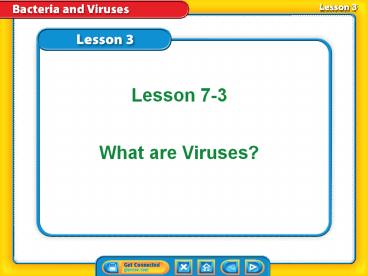Lesson 3 Reading Guide - PowerPoint PPT Presentation
1 / 18
Title:
Lesson 3 Reading Guide
Description:
Lesson 7-3 What are Viruses? Lesson 3 Reading Guide Lesson 3 A virus is a strand of DNA surrounded by a layer of protein that can infect and replicate in a host cell. – PowerPoint PPT presentation
Number of Views:90
Avg rating:3.0/5.0
Title: Lesson 3 Reading Guide
1
Lesson 3 Reading Guide
Lesson 7-3 What are Viruses?
2
Lesson 3
Characteristics of Viruses
- A virus is a strand of DNA surrounded by a layer
of protein that can infect and replicate in a
host cell.
3
Lesson 3
Characteristics of Viruses (cont.)
- A virus
- is smaller than the smallest bacteria!
- http//learn.genetics.utah.edu/content/begin/cells
/scale/ - Viruses contain proteins, nucleic acids can
reproduce - But..
4
Virus characteristics
Characteristics of Viruses (cont.)
- Viruses
- Dont eat, grow or breathe
- Do not have any organelles, or a cell membrane.
- They are NOT cells!
- Based on this info, do you think viruses are
living organisms???? - No!
- A virus is not a living thing because it does not
have all the characteristics of a living organism.
5
Lesson 3
Characteristics of Viruses (cont.)
- Viruses can have different shapes, such as
crystal, cylinder, sphere, and bacteriophage
shapes.
6
Bacteriophage virus
Characteristics of Viruses (cont.)
- Bacteriophage viruses only infect bacteria
Protein coat
7
Lesson 3
Characteristics of Viruses (cont.)
- Viruses must use organisms to carry on the
processes that we usually associate with a living
cell. - Viruses must be inside a cell, called a host
cell, to replicate.
8
Lesson 3
Characteristics of Viruses (cont.)
- When a virus enters a cell, it can either be
active or latent. - Latent viruses go through an inactive stage and
their genetic material becomes part of the host
cells genetic material. - Once it becomes active, a virus takes control of
the host cell and replicates.
9
Viral reproduction
Lytic Cycle
- Even though viruses are not truly a living
organism, they can reproduce. - How?
- The Lytic Cycle
- A 4-step process
- http//www.youtube.com/watch?vwVkCyU5aeeU
10
Lytic Cycle
Step 2 - injection
Step 1- attachment
Step 3- Replication
Step 4 - Escape
11
Lytic Cycle
Lytic Cycle
- Virus attaches to a host cell
- Virus injects DNA into the host cell
- Host cell is then directed to make more viral
DNA, and new protein coats (replication) - The host cell is often destroyed and the viruses
escape and move on to infect other cells
12
Lesson 3
Characteristics of Viruses (cont.)
- As viruses replicate, their DNA or RNA frequently
mutates, enabling them to adjust to changes in
their host cell. - Viruses cause many human diseases, such as
chicken pox, influenza, HIV, and the common cold.
Viruses can also affect other animals and plants.
13
Lesson 3
14
Lesson 3
Treating and Preventing Viral Diseases
- Since viruses are constantly changing, viral
diseases can be difficult to treat. - Antibiotics work only against bacteria, not
viruses. - One of the best ways to prevent a viral infection
is to limit contact with an infected human or
animal.
15
Lesson 3
Treating and Preventing Viral Diseases(cont.)
- When a virus infects a person, their body begins
to make antibodies. - An antibody is a protein that prevents an
infection in your body. - Antibodies bind to viruses and other pathogens
and prevent them from attaching to a host cell.
16
Lesson 3
Treating and Preventing Viral Diseases(cont.)
- Natural immunity develops when a mother passes
antibodies on to her unborn baby.
17
Lesson 3
Treating and Preventing Viral Diseases(cont.)
- A vaccine is a mixture containing material from
one or more deactivated pathogens, such as
viruses. - When an organism is given a vaccine for a viral
disease, the vaccine triggers the production of
antibodies. - After being vaccinated against a particular
pathogen, the organism will not get as sick if
exposed to the same pathogen again.
18
Lesson 3
Research with Viruses
- Scientists are researching new ways to treat and
prevent viral diseases in humans, animals, and
plants. - Viruses have been used by some scientists to
treat genetic disorders and cancer using gene
transfer.



























![Honors Level Course Implementation Guide [English Language Arts] PowerPoint PPT Presentation](https://s3.amazonaws.com/images.powershow.com/7928665.th0.jpg?_=20160626066)



